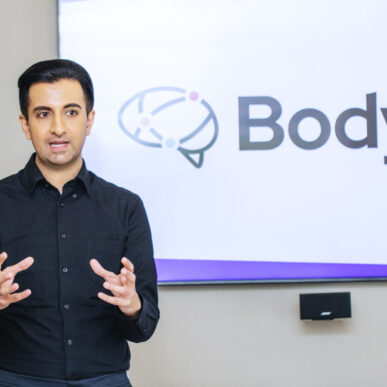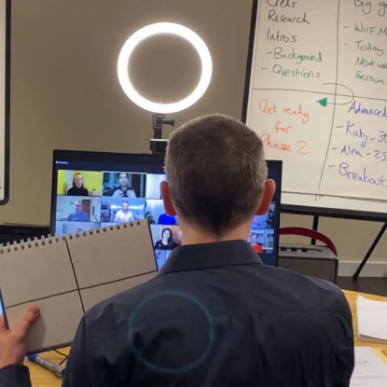What’s The Story? How To Make Facts, Data and Lists Compelling

Data has power.
But it won’t impress people by itself. You need a compelling narrative to engage your audience, with data supporting your key points along the way.
DATA IS NOT THE MAIN EVENT. YOUR STORY IS.
Some people think a presentation is about sharing numbers, facts, and information. This is simply untrue. You need to tell people what those numbers mean in the context of a larger story so that they truly understand them and can take the right action.
The world we live in has people obsessed with looking professional and therefore leading with data. They have forgotten the way human beings evolved to hear and listen to information.
You need to speak to people in a way that first appeals to their instinctual and emotional sides, before speaking to their logical mind.
And that means telling a story.
Here are a few of the best ways to present your data in clear, compelling stories.
1. ANCHOR THE DATA IN SOMETHING PERSONAL.
There’s a well-known phrase that says, “If 1000 people die, it’s a statistic. If one person dies, it’s a tragedy.”
What that means is people are overwhelmed by large numbers and cannot clearly comprehend what they mean. But if they only have one person — or one story — to focus on, they’re much more likely to engage with what they’re hearing.
And so we have to consider: How will your data impact one human being? How will this issue apply to their life? By answering these questions we can gain personal understanding of the numbers.
To give you an example, I often coach speakers who feel nervous that their content isn’t going to have an impact. I remember one client in particular, who was speaking about health and safety. I asked him how he felt about his content, and he said, “I hate doing this. Nobody ever listens to me.”
I suggested he try telling a story about his data to see if it engaged the audience better.
When it came time for his presentation, he got on stage and, instead of laying out statistics and graphs, he told a story about one of his best friends.
He talked about how he and Jonathan started at the company on the same day and progressed together through their careers. The speaker was Jonathan’s best man at his wedding and the godfather to his daughter.
“One day a couple of years ago,” he recounted, “Jonathan came in, walked past the safety goggles, and chose not to put them on that day. He was pouring chemicals into the container, like so many of us do every day, and there was an explosion. From that day forward he’s been blind.”
“He’ll never see his daughter grow up,” the speaker continued. “And so I want you to think about this the next time you see the health and safety goggles. Don’t think about me, or my numbers, or my data. Think about Jonathan. Think about your life, your future, and what it would mean for you if there’s an accident.”
When we touched base a year later, he said that his presentation had gone from being a dull talk that people didn’t remember, to suddenly everybodycaring about health and safety.
All because he took data and turned it into a story.
2. MAKE YOUR FACTS, DATA, AND LISTS TANGIBLE.
People can’t get their head around numbers.
If you mention “50,000,” most people don’t know how to visualize what you’re talking about. It sounds like a big number.
Now imagine you describe this number in terms of investments. If you’re trying to upgrade your website, and you say: “Last week, 50,000 people came to our website, but the website’s not very good, so we must get new investment to improve it.” Your audience might not feel motivated.
However, if you tell a story that frames the data, you’re going to have more ears willing to listen.
You can frame “50,000” with commonly shared experiences. Bring up the Super Bowl, Madison Square Garden, or Wembley Stadium. Ask if anyone in your audience remembers the roar of the crowd, the rush of bodies trying to swarm in and out of the building, and how it took hours to leave because of the sheer mass of people. Perhaps they can remember how amazing, or how terrible, a certain performer was on stage.
Then give them the context of that number. You can say: “That crushing number of people is the same number of people who are looking at our website week after week. We’re the focal point. We’re the rockstar. We’re the team that they’ve come to see play. And we’re not doing a good job of it when we go on stage. So we have to make sure we get the investment behind our website so that we shine in front of that audience.”
By giving people a tangible image to hold in their minds, they’ll better understand the importance of your argument.
Instead of a bunch of numbers on a screen, they’ll have a vivid, sensory experience behind what you’re saying.
3. INTEGRATE YOUR FINDINGS IN THE HEADLINE.
Ed Cray, a professor of journalism, has some crucial advice around headlines.
He says once you’ve gathered all of your facts, data, and evidence, you need to decide what to keep and what to throw away. You decide this by writing your headline. And once you have your headline down, you strip out everything from your presentation that doesn’t support it.
Because if it has nothing to do with the headline, it won’t help you tell the story.
For example, let’s look back at the 2000 Olympics in Sydney. A former gold medal-winning rower was speaking about training with his team for this event. They had one headline message that kept them focused through four years of training.
“Will it make the boat go faster?”
If anyone was having a conversation or an argument that didn’t focus on making the boat go faster, they’d drop it and move on to something else. The rower said it kept them deadly focused for years, which is exactly what they needed to take home gold.
You must do the same with your data. Get all of the data. Figure out what story the data is telling you. Decide your headline, then use data that highlights the key points, with personal and tangible examples.
Data, case studies, and evidence are critical because they prove that your suggestions and ideas are valid. You’re effectively showing that your ideas about the past and your beliefs about the future are based on solid proof.
And there are few things more powerful than a guaranteed future.
So embrace data, find the meaning within it, and use it to make your story compelling.
To learn more about how we can help you please contact our team.




















